 Randy Caparoso is an award winning wine professional and journalist, living in Denver, Colorado. For a free subscription to Randy's Organic Wine Match of the Day, visit the Denver Wine Examiner.
Randy Caparoso is an award winning wine professional and journalist, living in Denver, Colorado. For a free subscription to Randy's Organic Wine Match of the Day, visit the Denver Wine Examiner. The French have been making sparkling wine in California for so long, you almost overlook the extraordinary quality of their wines: the closest thing to fine, complex champagne grown and produced outside Champagne, France in the world.
Each of the major firms have made dramatic impacts on the industry: beginning in the mid-1970s, Domaine Chandon with its focus on the three classic grapes of Champagne (Chardonnay, Pinot Noir and Pinot Meunier) grown in the coolest section (Carneros) in Napa Valley; Mumm Napa with its brilliant blending in adjustment to California’s sunnier climes, Roederer Estate for its bold exploration of Mendocino’s Anderson Valley, and now, Domaine Carneros by Taittinger for its French-like sense of long-term sustainablility, moving towards 100% organic grape growing soon after establishing its 300 acres in Carneros in 1987.
Consider this: in the early 1990s it wasn’t quite hip to be green; especially among neighbors who, although they may farm sustainably, still insist on the option of zapping their vines at the first sign of trouble. After receiving CCOF certification in 2008, Domaine Carneros’ longtime President and Chief Winemaker (since 1989) Eileen Crane (pictured above) remarked, “Certified organic viticulture means you can’t just give the vineyard a shot of penicillin when it gets sick.”
Committing to organics, especially in the beginning, is a process, often at the expense of perceived efficiency. Instead of wiping out mealy bugs with chemicals, for instance, you use chickens, who love mealy bugs. “Now, of course,” says Crane, “we have to protect the chickens from coyotes… if you think outside the box, some experiments might not work out, but you learn from them what the next step should be.”
 Green consciousness has always been important to Domaine Carneros (the winery also employs solar power, skylights and underground insulation rather than refrigeration), but the evolution has always been one and the same with that of this centuries old French Champagne house’s first priority, which is producing the finest wines. “We believe that you achieve this through healthy vines,” say Crane, while adding, “you want to be part of something that’s not just for the moment… we want people to enjoy their jobs and the vines.”
Green consciousness has always been important to Domaine Carneros (the winery also employs solar power, skylights and underground insulation rather than refrigeration), but the evolution has always been one and the same with that of this centuries old French Champagne house’s first priority, which is producing the finest wines. “We believe that you achieve this through healthy vines,” say Crane, while adding, “you want to be part of something that’s not just for the moment… we want people to enjoy their jobs and the vines.”I’ll toast to that, which brings up our organic wine match of the day: the 2005 Domaine Carneros Brut (about $26); and make no mistake, this is as fine a sparkler made in California, organic grapes or not. In the classic Taittinger style, the highlight is its texture – creamy smooth, like waves of silk caressing the lips – and wispy fragrances of wildflowers, baking apples, rising bread and buttery slivers of toasted hazelnut, extending over a long, zesty palate of distinct delicacy.
Light and lovely sparklers like this certainly don’t need food to be complete; like food, its refined effervescence is resuscitative in itself. But you can also think of the Domaine Carneros in the same way as you would most lighter bodied, dry or off-dry white wines with crisp, sharply defined acidity that freshens dishes like squeezes of lemon. White fish and minerally shellfish (shrimp, crab, oysters and lobster) are naturals, especially in the form of sashimi, tartare, seviche, salsas, Hawaiian poke, or in salads with mild, winey vinaigrettes.
Authentic Hawaiian Poke
 Speaking of which, have you ever had authentic Hawaiian poke (pronounced POH-kay)? Even in the Islands, the variations are endless, but I can’t say that most Mainland renditions, done at the hands of “creative” chefs, come decently close to the Hawaiian originals. When in doubt, stick to the simple, original style, in which you can taste the ocean itself.
Speaking of which, have you ever had authentic Hawaiian poke (pronounced POH-kay)? Even in the Islands, the variations are endless, but I can’t say that most Mainland renditions, done at the hands of “creative” chefs, come decently close to the Hawaiian originals. When in doubt, stick to the simple, original style, in which you can taste the ocean itself.Although the early Hawaiian fishermen didn’t use soy sauce or chiles (their poke was probably no more than chopped seaweed, rock salt and ground kukui nuts), this is a version considered basic in Hawai`i today:
2 lbs. sashimi grade ‘ahi tuna, cut into bite-sized cubes (poke means “cut piece”)
½ cup soy sauce
3/4 cup chopped green onions
2 tbsp. sesame oil
1-2 tbsp. Hawaiian (preferably) rock salt, to taste
1 or 2 red chile peppers (small Thai types), cored, seeded and finely minced
1 tbsp. toasted sesame seeds
½-1 cup limu kohu (seaweed), blanched and chopped
1 tbsp. toasted macadamia nuts (ground or finely chopped)
Making this is simply a matter of tossing and mixing (chill before serving); and if you do it often, you end up going by feel rather than measurements. Although the reddish-brown limu seaweed is a key ingredient in the Islands, you can enjoy the pure taste of poke style tuna – with which a dry, yeasty, refined sparkler like Domaine Carneros washes over like a hissing, foamy soft wave climbing up a feathery, golden sand Hawaiian beach – without it.
The sesame seeds are another nice option; if you find the seeds plain, you can toast them by placing them in a small dry saucepan over medium heat, stirring occasionally until golden brown (about three minutes). Finally, although I can usually do without the macadamia nuts, I’d add it in for the Domaine Carneros because, like the sesame seeds, it offers a nice flavor bridge to the wine’s toasted nut nuances. To toast whole macadamias, spread them over a baking sheet in a preheated 300° F. oven 5-6 minutes, until lightly browned, and… aloha!
















